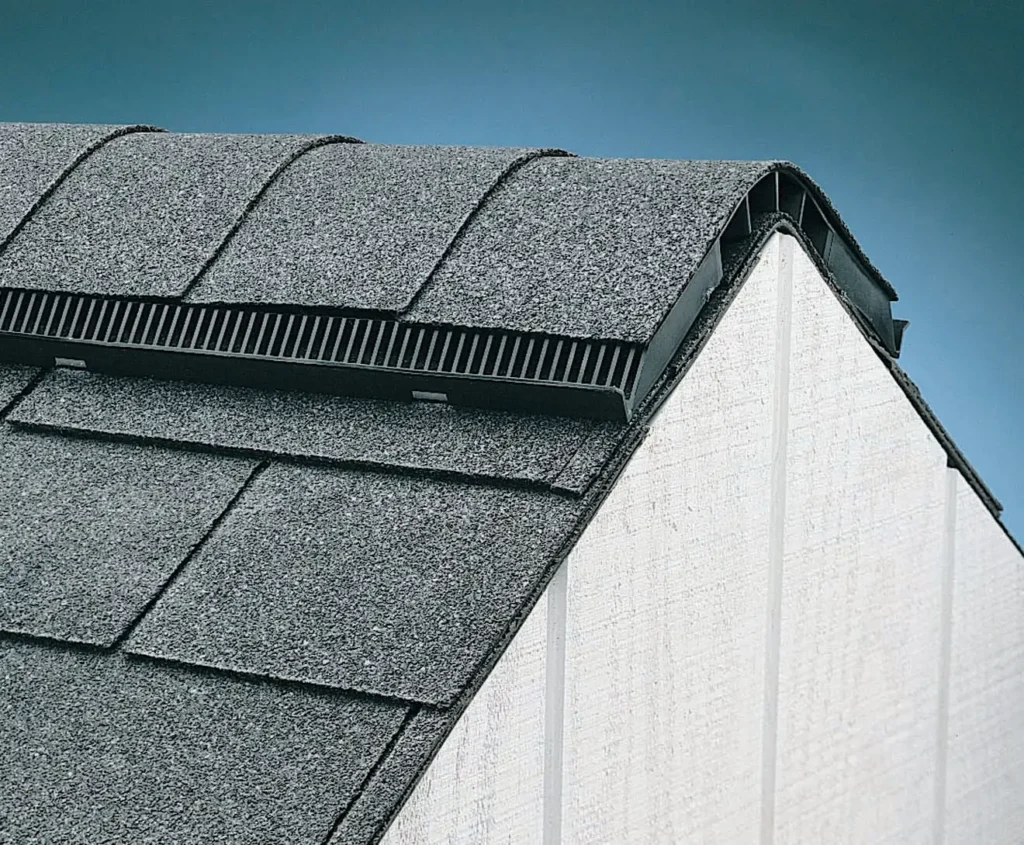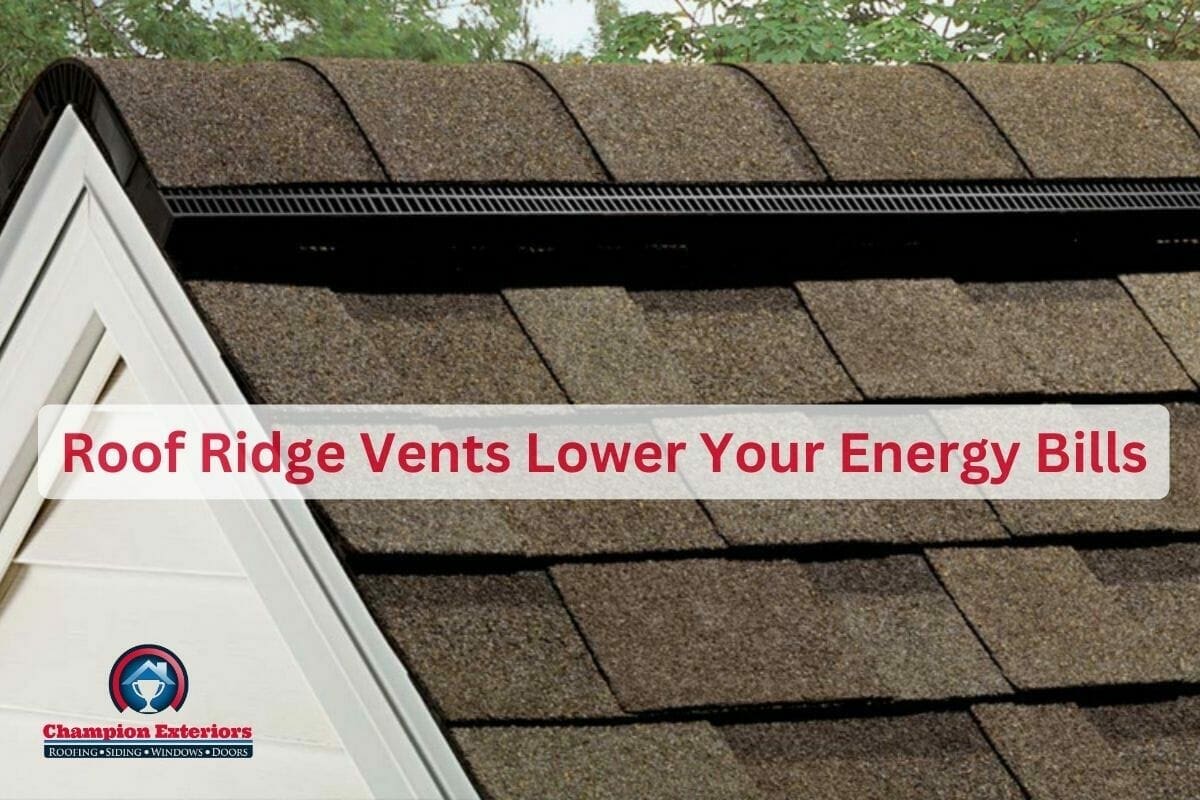Hot air rises due to its low density, especially when cool air replaces it. This natural principle bears a resemblance to the laws of heat transfer, wherein heat moves from regions of higher temperature to regions of lower temperature.
Roof vents stick to the same principle and work accordingly, providing an exit for the hot air that’s risen to an attic space. These vents are important because if hot air remains trapped inside your attic, it will cause damage to the roofing materials and structure.
To overcome these issues, roof ridge vents play an important role in maintaining proper ventilation throughout your home. They exhaust stale and warm air outside the attic, allowing it to be replaced by the cool air coming in through soffit vents.
What Are Roof Ridge Vents?
If you’ve ever been on your roof, you might have seen ridge vents installed along the roof’s ridge line. Ridge vents are a type of passive vent that works without the need for a mechanical system. As they are installed on rooftops, roof ridge vents exhaust or pull the warm and humid air out of an attic. Thus, they promote the circulation of air throughout a home, especially when used in tandem with soffit vents.
Roof ridge vents work on a basic principle called convection. This means that as temperatures change in a home or building, the warm and humid air will rise, leaving space for cool air to replace it, circulate, and complete the cycle. Without the correct ventilation, warm air will sit against the roof, deteriorating the roof deck, shingles, or other roofing material installed.
With the help of convection, roof ridge vents provide a space for the hot and humid air to exit your home instead of pressing up against the structure of your roof without escape.
Ridge Vents In Winter
When you want to reduce the amount of cold inside your home in the winter, you may try different heating systems to maintain the temperature throughout.
Without ridge vents, the hot air that you’re generating to heat your home will become trapped and cause an imbalance in the overall temperature inside a home. As a homeowner, you then may have to deal with the problem of ice dams. Ice dams form when the top of the roof is warmer than the edges, which causes snow to melt and refreeze as it reaches the edge. This leads to severe water damage if not addressed.
By installing ridge vents along the ridge of your roof, you’re less likely to deal with ice dams and hence, the costly expense of paying for roof repairs or replacements caused by water damage.
Ridge Vents In Summer
During the summer, when the sun’s rays hit your roof at maximum intensity, it significantly increases the attic temperature, making the air in the attic hotter.
We know that heat transfers from higher-temperature areas to lower-temperature areas. Following the same pattern, the warm air in your attic moves and settles against the roofing material if there are no ridge vents to exhaust it, heating up the roofing material on the exterior of your home. This heats up the area above and below the roof, and if you have insulation, the heat and moisture will ruin it.
Additionally, in response to excessive heat, an HVAC unit will have to work harder to balance the interior temperature and hence, charge you more money.
Since the cost of your energy bills depends on the size of your home, its level of insulation, and more, it is hard to estimate the total savings that ventilating your home can bring. An average estimate suggests that roof ridge vents installed along the roof’s ridge can lower energy bills by 10%.
During the summer, combining roof ridge vents with soffit vents can significantly reduce energy bills. Additionally, when combined with other attic vents, such as gable vents, energy costs are reduced even further and save you more money.

The Advantages Of Roof Ridge Vents
There are many advantages to installing roof ridge vents, including improving the air quality inside your home, increasing your roof’s lifespan, and reducing the risk of damage to roofing components.
Improve Air Quality
Roof ridge vents improve indoor air quality by reducing the amount of moisture and pollutants that accumulate in an attic. Without proper ventilation, moisture can build up in the attic, leading to the growth of mold and mildew, which may contribute to respiratory problems and allergies. Roof ridge vents allow for proper air circulation, which helps to prevent the buildup of moisture and pollutants, resulting in improved indoor air quality.
An Increased Lifespan
Roof ridge vents increase your roof’s lifespan by reducing the amount of heat trapped in the attic. High temperatures in the attic can cause damage to the roof deck and shingles, leading to premature aging and deterioration. By reducing the temperature in an attic, roof ridge vents help to protect the roof from heat-related damage, which extends the overall lifespan of your roof.
Reduce The Risk Of Damage
Roof ridge vents also reduce the risk of a roof developing moisture damage. Moisture buildup in an attic can lead to the growth of mold and mildew, which may cause structural damage to the roof and walls. In addition, moisture can condense on the underside of the roof decking, and along any insulation in your attic, leading to damage and rot. By allowing for a proper level of air circulation, roof ridge vents help prevent moisture buildup, reducing the risk of damage to your home.
How To Install Roof Ridge Vents
Installing roof ridge vents isn’t a hassle for a professional and skilled roofer. Using the right techniques and quality materials during installation will bring many benefits to your home and roof.
Materials And Tools Required
To install roof ridge vents on your roof, you’ll need certain tools and the required materials. The exact requirements may vary depending on the type of vent you are installing and the specific dimensions of your roof. Generally, you’ll need a circular saw, or reciprocating saw, to cut the roof decking and shingles, a roofing hammer, nails or screws, roofing cement, and a utility knife. You may also need a chalk line to mark the area where the vent will be installed and a ladder to access the roof.
A Step-By-Step Guide To Installing Successful Roof Ridge Vents
1. Choose the appropriate vent: The first step is to select the right type of vent that is suitable for your roof’s design and the climate in your area.
2. Measure and mark: Measure the length of the roof and mark the location where you will be installing the vent. You can use a chalk line to make sure the marks are straight.
3. Cut the roof decking: Use a circular or reciprocating saw to cut the roof decking along the marked line. Cut the decking so that it is about an inch wider than the vent.
4. Install the vent: Position the vent on the opening once the decking is cut. Make sure it is level and centered. Nail or screw the vent in place.
5. Seal the edges: Apply roofing cement along the edges of the vent to ensure a secure seal. This will prevent water from seeping in.
6 Cut the shingles: Cut the shingles to fit around the vent. Ensure the shingles overlap the edges of the vent by at least 6 inches.
7. Secure the shingles: Nail them in place, ensuring they are securely fastened.
8. Seal the shingles: Apply roofing cement around the edges of the shingles to create a watertight seal.
9. Finish up: Once the vent is installed, clean up any debris or leftover materials from the installation process.
Tips For A Successful Installation
To ensure a successful installation of the roof ridge vents, it is essential to take certain precautions. First and foremost, choosing a vent appropriate for your specific roof and climate is crucial. In addition, you must thoroughly inspect the area and clean it. As dirt, dust, and debris accumulate on your roof, it must all be cleared before the installation.
Also, you must pay careful attention when cutting the shingles and decking to ensure a proper fit for the vent.
Do You Want To Install Ridge Vents On Your Roof?
If you want to install ridge vents along your roof in New Jersey, contact Champion Exteriors today at (609)-845-3576. We install effective roof ventilation systems that make your living space comfortable. Our team of contractors is experienced in handling all types of roofing projects, including roof installation, replacement, gutters, and siding. So, call us today to find out how we can help you with your ventilation needs!


